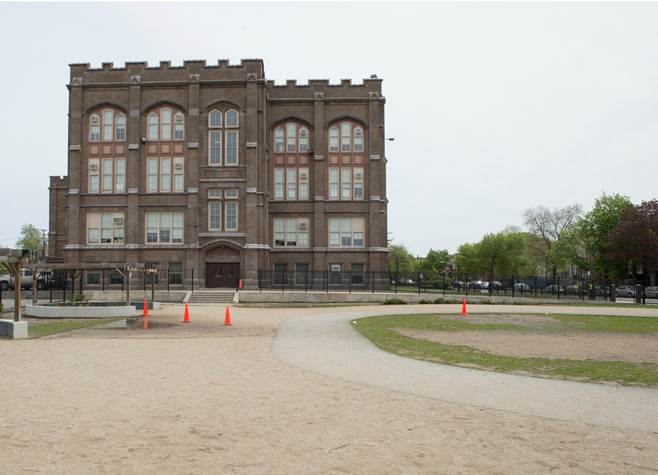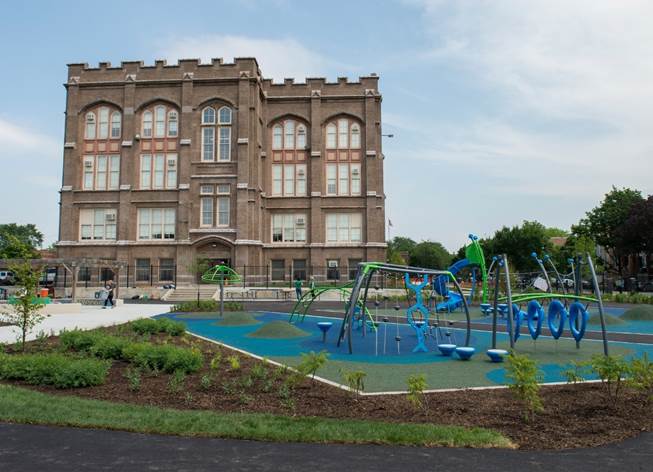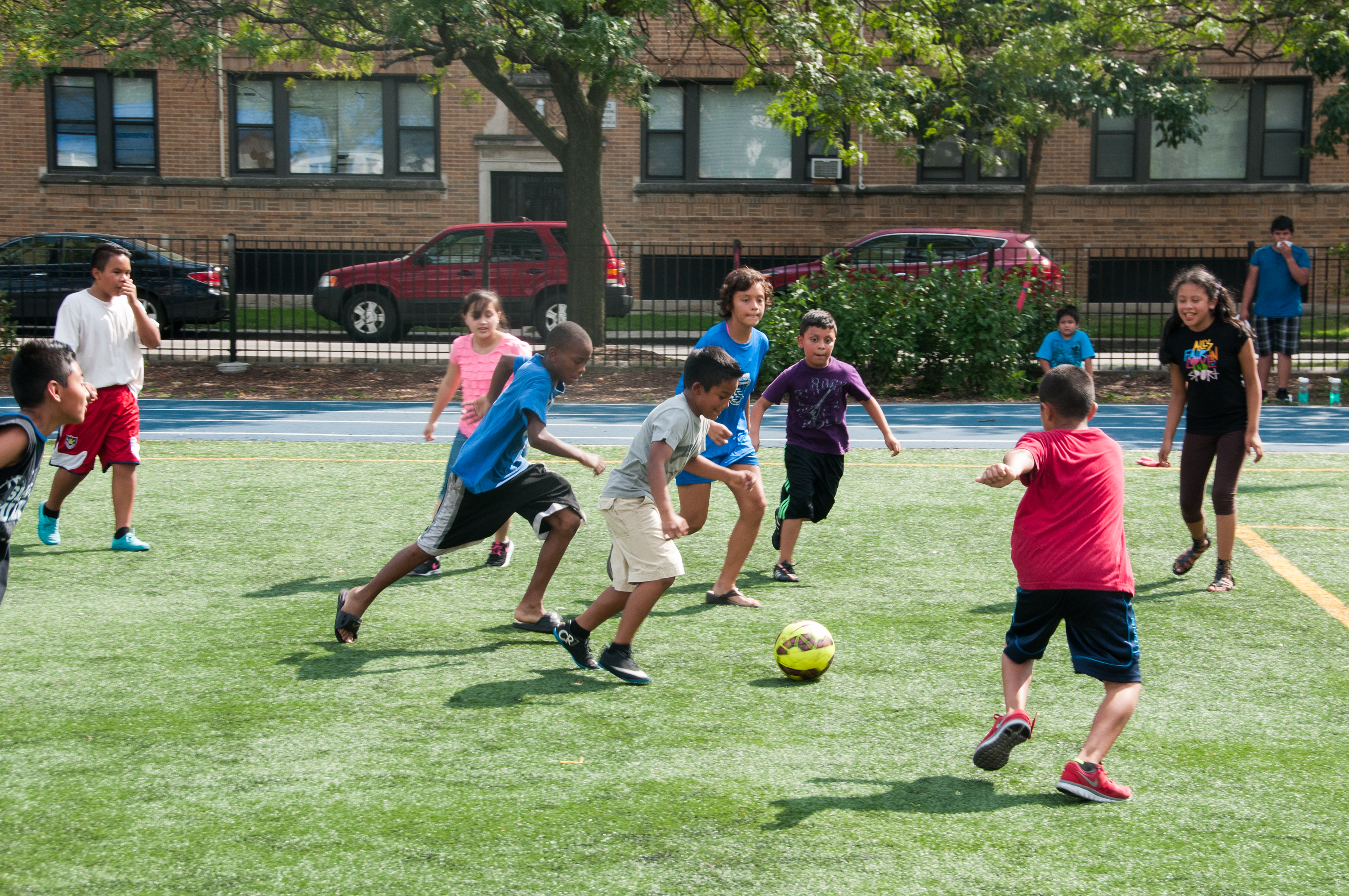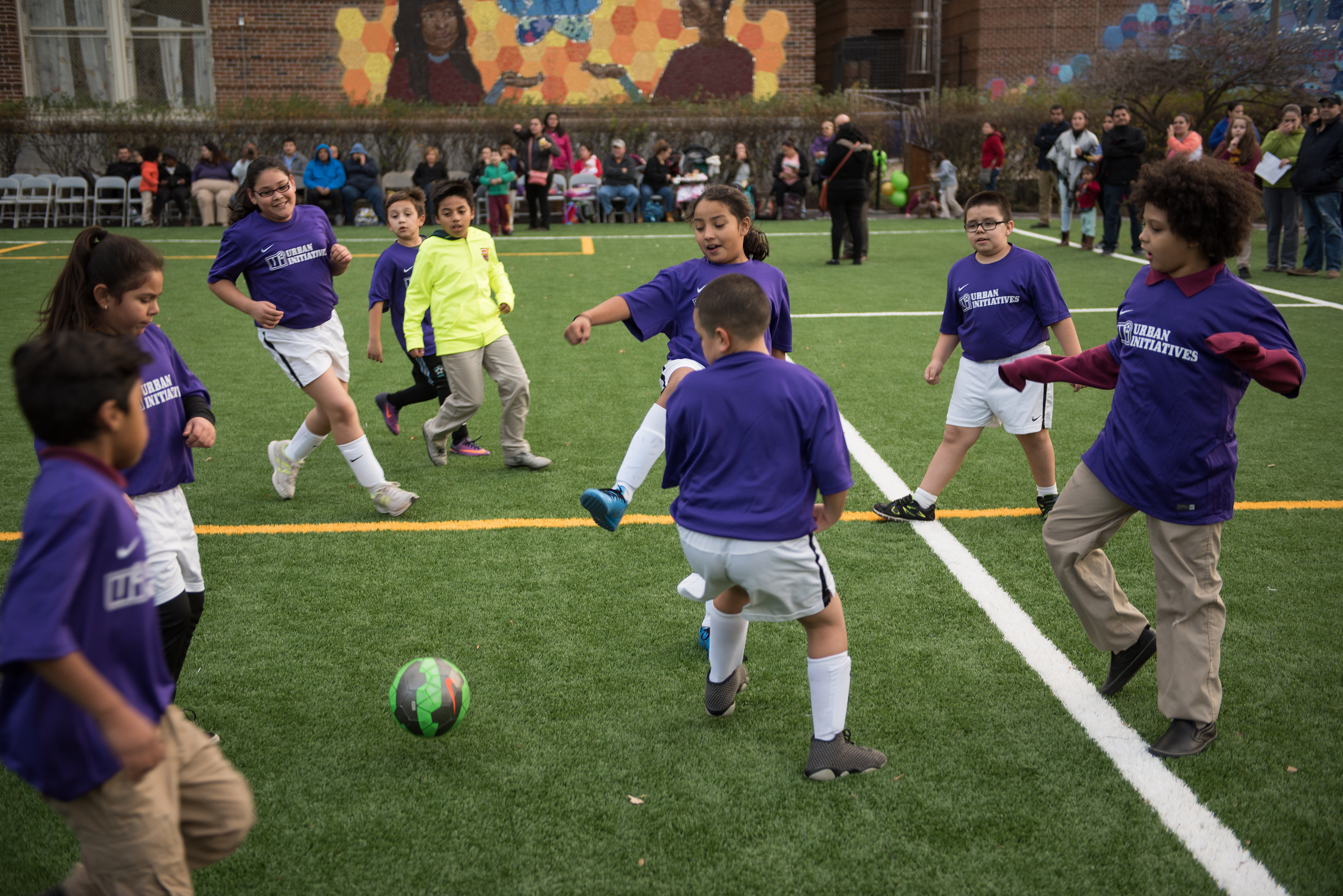Space to Grow Green Schoolyard Partnership
Thanks to the Space to Grow program, the James Wadsworth Elementary
School has a new look to its schoolyard with a new play area, community
space and landscaping that will retain more than 130,000 gallons of
rainwater. As a funding and engineering partner of the program, the MWRD was
excited to help document the three-month construction transforming the
schoolyard at Wadsworth Elementary with a time-lapse camera. The schoolyard
opened in November 2016.
Overview
Space to Grow is a public school playground rehabilitation program co-managed by Chicago-based nonprofits Healthy Schools Campaign and Openlands and funded by the Metropolitan Water Reclamation District of Greater Chicago (MWRD), Chicago Public Schools (CPS) and the Chicago Department of Water Management (DWM). The partners have committed to building 34 schoolyards by 2022; the ultimate goal is to change the way schoolyards are built so they are providing multiple community benefits.
The goal of the Space to Grow program is to transform Chicago’s schoolyards into vibrant outdoor community spaces for physical activity, outdoor learning, environmental literacy and engagement with art, while addressing neighborhood flooding issues. Crumbling asphalt and neglected playground equipment in flood prone neighborhoods is replaced with multi-use “green” schoolyards. Each new schoolyard is unique and the plans incorporate many improvements such as turf fields, jogging tracks, basketball courts and age-appropriate play equipment. The grounds also feature areas for outdoor learning and exploration, outdoor classrooms, vegetable gardens and rain gardens. The schoolyards are designed to include ground surfaces and landscape features that absorb large amounts of water, which will result in less neighborhood flooding.
The MWRD encourages CPS to design projects with the maximum Design Retention Capacity (DRC) possible. DRC is the amount of water held by green infrastructure (GI) technology that is absorbed into the ground rather than into local sewers and basements. The 10 schools Space to Grow has completed have a DRC of 1.5 million gallons. As more projects are designed and completed, the MWRD and the CPS design consultants are learning how to increase DRC in future projects.
Each schoolyard renovation costs approx. $1.5 million. Big Green Chicago donates edible garden beds and facilitates training and edible garden support at many Space to Grow schools.
The first 15 schoolyards combined have the ability to capture 2,511,569 gallons of water per rain event which is equivalent to 3.8 Olympic-sized swimming pools.
|
School |
Design Retention Capacity |
|
2014 |
|
|
Grissom |
253,902 |
|
Leland |
128,197 |
|
Morrill |
118,098 |
|
Schmid |
230,807 |
|
Total |
731,004 |
|
2015 |
|
|
Cather |
56,152 |
|
Orozco |
308,352 |
|
Total |
364,504 |
|
2016 |
|
|
Corkery |
102,738 |
|
Gunsaulus |
152,517 |
|
Wadsworth |
133,393 |
|
Total |
388,648 |
|
2018 (Construction in progress) |
|
|
Cook |
217,978 |
|
Davis* |
197,422 |
|
Fernwood |
138,222 |
|
Field |
170,060 |
|
Morton |
150,952 |
|
Farnsworth |
152,869 |
|
Total |
1,027,503 |
|
GRAND TOTAL |
2,511,659 |
*School completed June 19, 2018
2014 recap
Amount of water captured per storm event constructed: 731,004 gallons.
Schoolyards constructed
Grissom Elementary School, 12810 S. Escanaba Ave., Hegewisch neighborhood (253,902 gallons)
George Leland Elementary School, 512 S. Lavergne Ave., Austin neighborhood (128,197 gallons)
Donald L. Morrill Math & Science School, 6011 S. Rockwell St., Chicago Lawn neighborhood (118,098 gallons)
Schmid Elementary School, 9755 S. Greenwood Ave., Cottage Grove Heights neighborhood (230,807 gallons)
Summary: 2014 was the pilot year of the Space to Grow program and four new schoolyards were constructed at Chicago Public Schools: Grissom Elementary School in Hegewisch, Leland Elementary School in Austin, Morrill Elementary in Chicago Lawn, and Schmid Elementary School in Pullman. Each school was engaged in a months-long planning process during which school staff, students and community members provided input. The schoolyards were then constructed to meet the unique needs and goals of each community. The total DRC for the four pilot schools is 731,004 gallons. Due to the success of the pilot program, the MWRD committed to partially fund 30 more elementary schools starting in 2015. These schools continue to serve as meeting places for the community to enjoy and learn about the benefits of green infrastructure, like rain barrels and rain gardens that also work to prevent flooding.
Morrill Elementary School
2015 recap
Amount of water captured per storm event constructed: 364,504 gallons.
Schoolyards constructed
Willa Cather Elementary School, 2908 W. Washington Blvd., East Garfield Park neighborhood (56,152 gallons)
Orozco Fine Arts & Sciences Elementary School, 1940 W. 18th St., Heart of Chicago neighborhood (308,352 gallons)
Summary: New school grounds were celebrated in 2015 at Willa Cather Elementary School, 2908 W. Washington Blvd., in the East Garfield Park neighborhood, and Orozco Academy, 1940 W. 18th St., in the Woodlawn neighborhood. Together, these schools can retain 364,504 gallons of stormwater.
Cather’s scope of work started with the removal of asphalt, an old playground and fencing. Site improvements included two age-specific playgrounds on rubber play surfacing, enlarged basketball and volleyball courts on permeable asphalt, an asphalt track, baseball backstop, artificial turf, an outdoor classroom, an enlarged running track, and walkways. Stormwater improvements included a community garden, rain gardens, permeable walks, and infiltration planters. Site amenities included fencing, signage, and site furnishings.
Orozco’s scope of work started with the removal of asphalt, fencing, and utilities. Site improvements included two age-specific playgrounds on rubber play surfacing, basketball courts, an artificial turf soccer field, painted asphalt track, an outdoor classroom, permeable pavers walkways, and asphalt with painted games. Landscape improvements included a community garden, rain gardens, and infiltration planters that directly receive roof runoff through disconnected gutters. Site amenities included fencing, signage, and site furnishings, and utility upgrades included stormwater storage, downspout disconnections, lawn hydrants, and electrical renovations.
Educational signage was placed at the sites to inform students and the surrounding community of the benefits of GI. Neighborhood residents were involved in the installation of GI, and groundbreaking ceremonies were hosted and well attended.
Cather Elementary School
2016 recap
Amount of water captured per storm event constructed: 388,648 gallons.
Schoolyards constructed
Daniel J. Corkery Elementary School, 2510 S. Kildare Ave., Little Village neighborhood (102,738 gallons)
Gunsaulus Scholastic Academy, 4420 S. Sacramento Ave., Brighton Park neighborhood (152,517 gallons)
James Wadsworth Elementary School, 6650 S. Ellis Ave., Woodlawn neighborhood (133,393 gallons)
Summary: The Space to Grow program partners unveiled three new schoolyards at James Wadsworth Elementary School in the Woodlawn neighborhood, Gunsaulus Scholastic Academy in the Brighton Park neighborhood, and Daniel J. Corkery Elementary School in the Little Village neighborhood in 2016.
Wadsworth, 6650 S. Ellis Ave., includes an athletic field with artificial turf, a running track, a basketball court, a playground with poured-in-place rubberized surface and vegetable gardens donated by The Kitchen Community. Wadsworth plans to use the new schoolyard to enhance its Science, Technology, Engineering and Mathematics (STEM) curriculum, while also exploring many new options for PE class, recess and healthy initiatives for the entire community through outdoor Zumba classes. More than 50 percent of the new surface of the schoolyard is pervious compared to the nearly 100 percent impervious grounds prior to construction. The campus features a cistern capturing roof runoff, a rain garden capturing runoff from the track and a subsurface aggregate-filled storage area holding stormwater for gradual release to the combined sewer. Below the athletic field, rain garden and playground, an underground storage area consists of 276 cubic yards of aggregate tantamount to about 400 tons or 20 truckloads. More than 130,000 gallons of rainwater is stored temporarily in the pore space between individual aggregate and slowly released to the sewer or infiltrated into the subsoil. Students, parents and community members pitched in to plant 33 trees, 42 shrubs and 1,788 perennials and assisted with painting a new fence and other finishing touches.
Corkery, 2510 S. Kildare Ave., holds water that would otherwise flow into the combined sewer system that can back up into neighbors’ basements. The schoolyard retains a volume of 102,738 gallons, equal to about 10 backyard swimming pools or 2,200 bathtubs. It uses deep-rooted vegetation in the landscaped areas with soil that has more open space to allow water to be stored and soak faster into the ground. More than 88,000 gallons are stored in the gravel under the athletic field. Pervious rubber playlots allow the water to soak through gravel beneath that can be stored while it soaks into the below soil. There are two different play structures for children ages 2-5 and children ages 5-12, each with fall-protection in the form of rubberized surfacing. There is a track around the outside of the athletic field, basketball hoops, stripes and removable post mounts for volleyball. There is also a raised-bed garden where children can grow and learn about healthy foods to eat and space for an outdoor classroom to be used by teachers. All of the sites constructed in 2015 or after have educational signs around the outside to explain the benefit of the stormwater features.
Patchy, compacted lawn and concrete at Gunsaulus, 4420 S. Sacramento Ave., were transformed into a new schoolyard that consists of an athletic field with artificial turf, a running track, a learning garden, an outdoor classroom, rain gardens and a bioretention basin. Planted with a mixture of native and deep-rooted ornamental plants, the rain gardens and the bioretention basin filter, detain, and allow infiltration of stormwater collected from the roof and impervious surfaces. Together with the aggregate-filled storage underneath the athletic field, the GI components combined to provide a stormwater storage volume of more than 150,000 gallons. Approximately 2,200 cubic yards of sand and stone aggregate, an equivalent of 3,000 tons or 150 truckloads, were used to create subsurface storage under the athletic field and in the bioretention area. The rainwater is stored temporarily in the pore space between individual aggregate and slowly released to the sewer or infiltrate into the subsoil. About 80 cubic yards of compost is mixed with sand in the bioretention area. There were also four trees, 132 shrubs and 5,142 perennials planted, including more than 2,000 perennials that were planted by students and community members.
Gunsaulus Scholastic Academy
2017 recap
Schoolyard construction postponed due to extenuating factors.
2018 recap
Amount of water captured per storm event to be constructed: 1,027,503 gallons.
Davis Elementary, 3014 W. 39th Place, Brighton Park neighborhood (197,422 gallons); the ribbon cutting was held June 19, 2018.
Cook Elementary, 8150 S. Bishop, Austin-Gresham neighborhood (217,978 gallons)
Farnsworth Elementary, 5414 N. Linder, Jefferson Park neighborhood (152,869 gallons)
Fernwood Elementary, 10041 S. Union St., Washington Heights neighborhood (138,222 gallons)
Field Elementary, 7019 N. Ashland, Rogers Park neighborhood (170,060 gallons)
Morton Elementary, 431 N. Troy, Humboldt Park neighborhood (150,952 gallons)
 Davis School, before |
 Davis School, after |
2019 recap
Schools to be transformed in 2019 include:
Ashe Elementary School, 8505 S. Ingleside Ave
Nash Elementary School, 4837 W. Erie St. and KIPP Academy Chicago, 4818 W. Ohio St. (two schools, one campus)
Ninos Heroes Elementary School, 8344 S. Commercial Ave.
Webster Elementary School, 4055 W. Arthington St.
Westcott Elementary School, 409 W. 80th St.
Looking ahead
The MWRD is currently working with the United States Geological Survey to monitor Morrill and Grissom schools using flow metering equipment to determine the effectiveness of the new playgrounds, both in terms of water quality and total stormwater flow reduction. The monitoring equipment was installed in September of 2016, and other schools will be monitored in the future.
Check back here for updates or visit www.spacetogrowchicago.org. For more information, contact Meg Kelly at (312) 419-1810.
Press releases and announcements
![]() CPS schools selected for schoolyard transformations in 2019
CPS schools selected for schoolyard transformations in 2019
![]() Nathan S. Davis Elementary Celebrates New Schoolyard Through Space to Grow: Greening Chicago Schoolyards
Nathan S. Davis Elementary Celebrates New Schoolyard Through Space to Grow: Greening Chicago Schoolyards
![]() Preparing Chicago schoolyards for water makes Space to Grow a Storm Water Solutions Top Project
Preparing Chicago schoolyards for water makes Space to Grow a Storm Water Solutions Top Project
![]() Time-lapse video captures Space to Grow transformation at Wadsworth Elementary School
Time-lapse video captures Space to Grow transformation at Wadsworth Elementary School
![]() Space to Grow partners win national Green Infrastructure Award
Space to Grow partners win national Green Infrastructure Award
![]() Collaboration for green schools earns Space to Grow national award
Collaboration for green schools earns Space to Grow national award
![]() Space to Grow program unveils two new schoolyard transformations
Space to Grow program unveils two new schoolyard transformations
![]() MWRD gives flood prevention tips through Space to Grow partnership
MWRD gives flood prevention tips through Space to Grow partnership
![]() Award-winning partnership builds healthy playgrounds, captures stormwater
Award-winning partnership builds healthy playgrounds, captures stormwater


